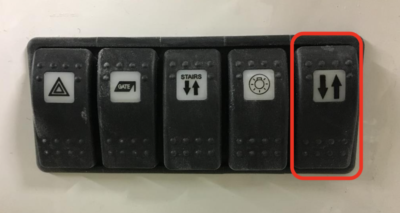The camper roof actuators are operated by a momentary toggle switch located in the main switch cluster on the shower wall. The roof circuit breaker (ROOF/STAIRS) is located on the Command Center and must be ON to operate the actuators.
There are no latches or locks to release or reset; EarthCruiser® utilizes worm drive actuators that incorporate an automatic locking and release system.
When raising and lowering the roof, ensure all four actuators are lifting at the same rate. If the roof is not lifting evenly, return the roof to the fully closed position and start again. Similarly, if there are any unusual noises during raising or lowering, cease operation and perform a visual check before proceeding. Raising or lowering the roof will take approximately 25 seconds. You may hear the roof scissor springs adjusting (creaking or squealing sounds) when in operation; this is normal.
When lowering the roof make sure all items inside are properly stowed, so they do not interfere with the curtain, or make contact with ceiling components. The roof has a preset closing height, when all actuators have stopped, the roof should be sealed and ready for travel.
There is a seal at the joint between the camper body and roof which prevents water from entering the house while driving. Periodically inspect the seal for weathering and replace if needed.
WARNING:
- The roof actuators have no automatic shut off other circuit breaker overload. Be very conscious of overhead obstructions when raising the roof. Also take care that nearby branches or leaves are not caught between the roof and the camper body.
- The roof should never be lowered with any person inside the camper.
- Never drive the vehicle with the roof in the raised position.
- If the circuit breaker switch clicks off, there has been an overload.
- The roof is not designed for additional loads. The installation of a roof rack, or placement of any weights on the roof is likely to cause damage to the roof structure, camper body, or the electric actuators.

